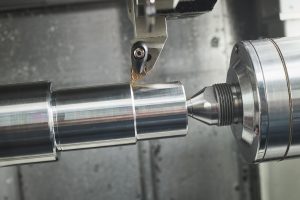The Difference Between Milling, Drilling, & Turning Machining Processes
Nov 29, 2021
CNC, which stands for Computer Numerical Control, is a modern manufacturing process for precision-made components relied on throughout the world. As technology has advanced, so too have the capabilities of CNC machines, making them incredibly important tools in precision manufacturing for applications ranging from aerospace and defense to specialty electronics and medical equipment. The key to that importance? Versatility. CNC machines support an enormous array of custom setups and tooling capabilities, allowing them to efficiently produce a high volume of complex parts.
As you read about what CNC machines are capable of, you’re likely to come across a variety of tooling terminology, such as turning, drilling, and milling. In this blog, we’ll explore the differences in these capabilities and how, in combination, they can be used to create 100% custom parts with extremely tight tolerances.
What is CNC Turning?
Turning is a subtractive manufacturing process wherein a workpiece is mounted to a lathe and rotated at high speeds. A cutting tool operates in linear directions and is introduced to the material at precise locations and depths. Turning is often confused with boring, which is similar in that both processes use a lathe and cutting tool. The key difference is that turning removes material from the exterior of the workpiece, whereas boring removes material from the interior.
What is CNC Milling?
Like turning, CNC milling is a subtractive manufacturing technique. However, with milling, it is the cutting tool that rotates while the workpiece remains fixed. The milling cutter is attached to a spindle which can operate on two or more axes. For example, a 2-axis milling machine can only cut horizontally and vertically. The most advanced CNC milling machines have five axes and incorporate rotational flexibility of the workpiece and cutting tool to allow for complex geometries.
What is CNC Drilling?
Drilling may seem like the most straightforward of the machining processes, as it simply produces round holes in a workpiece. However, a variety of considerations must be made to prevent issues, such as drifting, that can compromise precision. CNC drilling setups are designed to account for such problems and can be equipped for more complex machining capabilities, such as angular drilling.
Bringing Together Different CNC Machining Capabilities
For simpler applications that require material be subtracted from one side of a workpiece, 2- and 3-axis CNC machines are ideal. However, CNC machines are also capable of creating parts with complex geometries and are utilized in advanced manufacturing applications, such as for the aerospace industry.
Traditionally, creating such parts would require frequently resetting the workpiece and using a variety of machine setups. This was not only a drag on efficiency, but also sacrificed precision, as it required more manual interventions during the machining process. Advances in CNC machines are changing that. As noted above, modern 4- and 5-axis machines allow for greater rotational flexibility in both the cutting tool and workpiece, so complex parts can be created with less manual resetting.
When it comes to precision machining capabilities, Demmer Manufacturing’s portfolio companies are on the leading edge. By investing heavily in their technology, infrastructure, and people, we enable our affiliates to provide consistent performance, exceptional value, and continuity of supply for their clients across the globe. Learn more about our portfolio of precision manufacturing companies by visiting our portfolio page.

